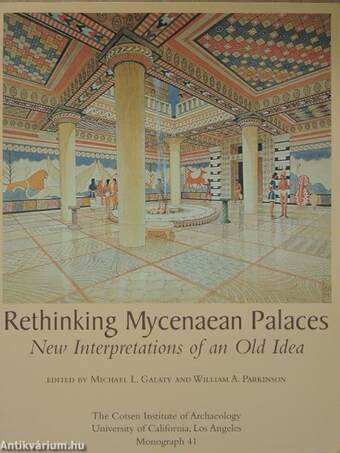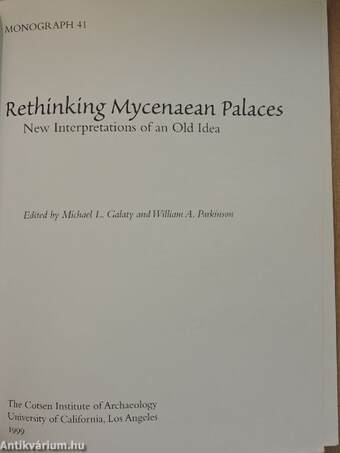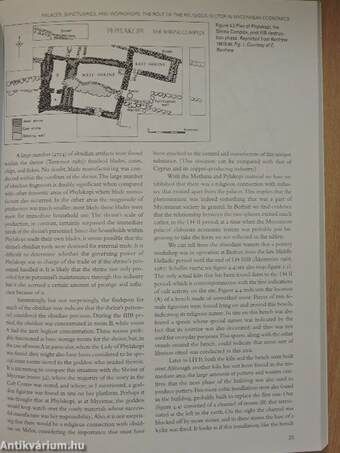1.067.017
kiadvánnyal nyújtjuk Magyarország legnagyobb antikvár könyv-kínálatát

VISSZA
A TETEJÉRE
JAVASLATOKÉszre-
vételek
Rethinking Mycenaean Palaces
New Interpretations of an Old Idea
| Kiadó: | The Cotsen Institute of Archaeology-University of California |
|---|---|
| Kiadás helye: | Los Angeles |
| Kiadás éve: | |
| Kötés típusa: | Ragasztott papírkötés |
| Oldalszám: | 119 oldal |
| Sorozatcím: | Monograph |
| Kötetszám: | 41 |
| Nyelv: | Angol |
| Méret: | 28 cm x 22 cm |
| ISBN: | 0-917956-94-x |
| Megjegyzés: | Fekete-fehér ábrákkal, illusztrációkkal. További kapcsolódó személyek a kötetben. |
naponta értesítjük a beérkező friss
kiadványokról
naponta értesítjük a beérkező friss
kiadványokról
Fülszöveg
This volume aims to define more accurately the term "palace" in light of both recent
archaeological research in the Aegean and current anthropological thinking on the
structure and origin of early states. Regional centers do not exist as independent entities;
rather, they articulate with more extensive sociopolitical systems. The concept of
palace needs, therefore, to be incorporated into enhanced models of Mycenaean state
organization, ones which more completely integrate primary centers with networks of
regional settlement and economy.
The research being done currently in the Aegean—particularly on Mycenaean state
formation—is of immense potential value to archaeologists working in other parts of
the world, beyond the confines of the easteni Mediterranean. It is specifically for this
reason that this volume has been published for a wider scholarly audience. It demonstrates
well, for example, the gains to be made through careful combination of
the documentary (in this... Tovább
Fülszöveg
This volume aims to define more accurately the term "palace" in light of both recent
archaeological research in the Aegean and current anthropological thinking on the
structure and origin of early states. Regional centers do not exist as independent entities;
rather, they articulate with more extensive sociopolitical systems. The concept of
palace needs, therefore, to be incorporated into enhanced models of Mycenaean state
organization, ones which more completely integrate primary centers with networks of
regional settlement and economy.
The research being done currently in the Aegean—particularly on Mycenaean state
formation—is of immense potential value to archaeologists working in other parts of
the world, beyond the confines of the easteni Mediterranean. It is specifically for this
reason that this volume has been published for a wider scholarly audience. It demonstrates
well, for example, the gains to be made through careful combination of
the documentary (in this case, Linear B) and material records, an approach of growing
interest to archaeology generally.
Michael L. Galaty is an Assistant Professor of Anthropology at Millsaps College in Jackson,
Mississippi. He holds degrees in anthropology from Grinnell College, Iowa (B.A.), and the
University of Wisconsin—Madison (M.A., Ph.D.). His doctoral dissertation has recently been
published as Nestor's Wine Cups: Investigating Ceramic Manufacture and Exchange in a Late Bronze
Age "Mycenaean" State (Oxford: British Archaeological Reports, 1999). His research interests
include ceramic ecology, the origins of Mycenaean states, European prehistory, and the
archaeology of monumental construction, especially North American and European burial
mounds. Galaty is also field director of the Mallakastra Regional Archaeological Project.
William A. Parkinson is completing his dissertation in the Department of Anthropology at the
University of Michigan. He received his B.A. in anthropology from the University of Illinois at
Chicago and his M.A. in anthropology from the University of Michigan. In addition to analyzing
stone tool assemblages from Neolithic and Bronze Age sites in the Aegean, he has worked
extensively in the Great Lakes Region of the United States. He is director of the Körös Regional
Archaeological Project—a project that seeks to understand the social organization of Early
Copper Age tribal societies on the Hungarian Great Plain.
Contributors: John Bennet, Emmett Bennett, Jr John Cherry. Jack Davis, Paul Halstead.
P. Nick Kardulias, J.T. Killen, Susan Lupack, Cynthia Shelmerdine, and David Small. Vissza
Témakörök
- Idegennyelv > Idegennyelvű könyvek > Angol > Művészetek > Építészet
- Idegennyelv > Idegennyelvű könyvek > Angol > Művelődéstörténet
- Művelődéstörténet > Kultúra > Története
- Művészetek > Építészet > Korszakok, stílusok > Ókor > Görög
- Művészetek > Építészet > Kontinensek szerint > Európa > Egyéb
- Művészetek > Építészet > Idegen nyelv > Angol
- Művészetek > Építészet > Műemlékek > Egyéb
- Régészet > Általános régészet, antropológia > Ókor
- Idegennyelv > Idegennyelvű könyvek > Angol > Régészet > Általános régészet, antropológia > Ókor
- Idegennyelv > Idegennyelvű könyvek > Angol > Régészet > Kontinensek szerint > Európa
- Régészet > Kontinensek szerint > Európa > Egyéb














